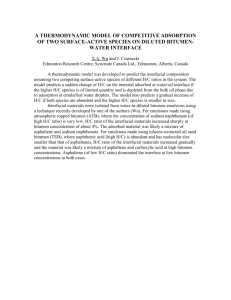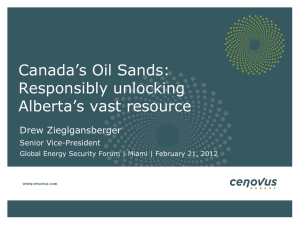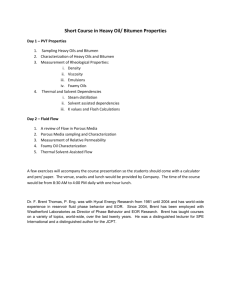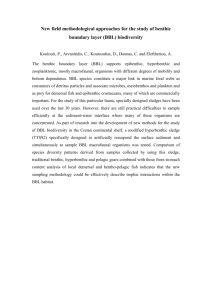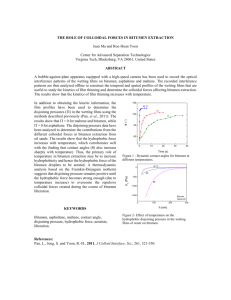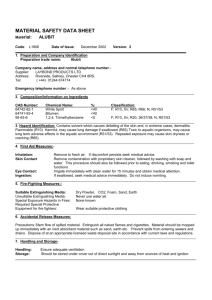Techniques for Maximizing Capital Cost Efficiency and Major
advertisement
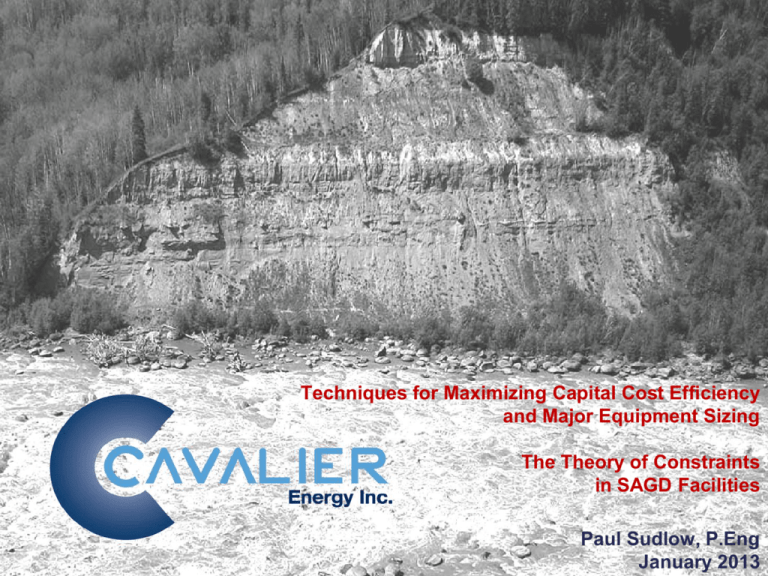
Techniques for Maximizing Capital Cost Efficiency and Major Equipment Sizing The Theory of Constraints in SAGD Facilities Paul Sudlow, P.Eng January 2013 Corporate Snapshot Background • In November 2011, Paramount contributed seed capital and all of its oil sands and carbonate bitumen assets to Cavalier • Cavalier has a 100% working interest in its main project areas • Cavalier is targeting to produce 80,000+ bbl/d from the Grand Rapids formation at its Hoole property with significant additional development potential from its portfolio of exploration lands − Includes carbonates properties adjacent to and on trend with the Laricina / Osum Saleski project, Eagles Nest and Christina Lake • New capital to be raised to fund ongoing development and the evaluation of opportunities for the achievement of greater scale in core areas • Cavalier plans to remain private through initial development phase • Cavalier is led by Dr. Will Roach, former President and CEO of UTS Energy Corporation − UTS was sold to Total E&P Canada Ltd. for $1.5 billion in 2010 plus the spinout of SilverBirch, which was sold for an additional $500 million in 2012 • Cavalier Asset Portfolio Overview • Reserves and Contingent Resource Summary Asset Hoole(1) Saleski Carbonates(2) Other Carbonate Leases(2) Total _______________ 1. Hoole volumes are probable undeveloped reserves and economic contingent resources as per McDaniel report effective December 31, 2012. 2. Carbonates volumes are contingent resources (technology under development) as per McDaniel report effective October 31, 2011. Reserves Probable Undev. MMbbls 93 93 Contingent Resources Low Best High Estimate Estimate Estimate MMbbls MMbbls MMbbls 511 719 903 380 567 111 184 511 1,210 1,653 2 Grand Rapids Industry Activity Grand Rapids Formation Generating Significant Interest • Industry peers have already applied for Grand Rapids SAGD projects totaling over 450,000 bbl/d of production capacity(1): – Cenovus: 180,000 bbl/d (pilot achieved first oil in Q3 2011 and filed commercial application in December 2011); 1st 60,000 bbl/d phase expected to start in 2017 – Laricina: 155,000 bbl/d (commercial application filed Q4 2011); First 5,000 bbl/d commercial phase under construction (first steam scheduled for Q2 2013); 30,000 bbl/d Phase 2 expected to start up in 2015 – BlackPearl: 80,000 bbl/d (pilot achieved first oil in Q3 2011 and filed commercial application in May 2012) – Koch: 40,000 bbl/d (10,000 bbl/d commercial application filed) Proximate to Significant Pre-Existing Producing Area • Hoole is directly adjacent to Cenovus and Canadian Natural’s Pelican Lake projects that are currently producing ~65,000 bbl/d from the Wabiskaw formation – Benefits from having significant pre-existing infrastructure (pipelines, natural gas, electricity, roads, etc.) in place _______________ 1. All based on publicly available information. • Hoole is targeted to be a material 80,000+ bbl/d project located in the core of the Grand Rapids resource play with opportunities for achievement of greater scale 3 Hoole Project Overview Development Stage Project with Expected Near Term Production • Filed regulatory application in November 2012 for 10,000 bbl/d Phase 1 with first production expected in 2016 – 93 MMbbls of probable reserves(1) at Phase 1 were recognized in Q1 2013 as a result • Delineation drilling for Phase 1 completed in 2010 (74 wells) • Environmental modeling complete and water source/disposal is selected, subject to regulatory approval • Preliminary front end engineering and design work completed • Risk mitigation strategy being implemented through construction of modularized components built off-site • Ability to truck production volumes for Phase 1 until area pipeline infrastructure is built _______________ 1. Hoole volumes and NPV as per McDaniel report effective December 31, 2012. 4 Forward Looking Statements Advisory Certain statements in this presentation constitute forward-looking information under applicable securities legislation. Forward-looking information typically contains statements with words such as "anticipate", "believe", "estimate", "expect", "plan", "intend", "propose", or similar words suggesting future outcomes or an outlook. Forward looking information in this presentation includes, but is not limited to: expected production volumes and the timing thereof; planned exploration and development expenditures, and the timing thereof; exploration, development and expansion plans and strategies for Cavalier’s properties; anticipated capital and financing requirements and access to capital; project economics, and comparisons to other oil sands projects, estimated production profiles and scope and the timing thereof; planned Hoole development schedules and costs, including cash flow profiles; reserves and resource estimates and the discounted net present value of future net revenues from such reserves and resources (including the forecast prices, costs and the timing of expected production volumes and future development capital); predicted recovery factors including steam oil ratios and cumulative steam oil ratios; construction and startup timelines and schedules; anticipated development activity in areas where Cavalier assets are located; expected pipeline capacity and ability to transport production when pipeline capacity is not available; business strategies and objectives; operating and other costs and strategies to reduce or mitigate such costs; and expected regulatory review and approvals and the timing and the outcome thereof. Such forward-looking information is based on a number of assumptions which may prove to be incorrect. The following assumptions have been made, in addition to any other assumptions identified in this presentation: future crude oil, bitumen and natural gas prices; general economic and business conditions; the ability of the Company to obtain required capital to finance its exploration, development and operations; the ability of the Company to successfully obtain equipment, services, supplies and personnel in a timely manner to carry out its activities; the ability of the Company to market its production; estimates of input and labour costs for an oil sands project; the ability of the Company to secure adequate product transportation and storage; the ability of the Company to successfully apply oil sands technology and to capitalize on improvements thereto; the ability of the Company to obtain project success including obtaining production volumes, steam oil ratios, capital and operating costs consistent and timing with expectations; the timely receipt of required regulatory approvals and the scope of such approvals; estimated timelines being met in respect of the development of the Hoole oil sands properties; access to capital markets and other sources of funding; and currency exchange and interest rates. 5 Forward Looking Statements Advisory • Although the Company believes that the expectations reflected in such forward looking information is reasonable, undue reliance should not be placed on it, as the Company can give no assurance that such expectations will prove to be correct. Forward-looking information is based on current expectations, estimates and projections that involve a number of risks and uncertainties which could cause actual results to differ materially from those anticipated by the Company and described in the forward looking information. These risks and uncertainties include, but are not limited to: fluctuations in crude oil, bitumen and natural gas prices, foreign currency exchange rates and interest rates; the uncertainty of estimates and projections relating to future revenue, future production, costs and expenses including project cost overruns; the ability to secure adequate product processing, transportation and storage; operational risks in exploring for, developing and producing bitumen, and the timing thereof; the ability to obtain equipment, services, supplies and personnel in a timely manner; potential disruption or unexpected technical difficulties in designing, developing, expanding or operating the Company’s projects; risks and uncertainties involving the geology of bitumen, crude oil and gas deposits; the uncertainty of reserves and resource estimates; changes to the status or interpretation of laws, regulations or policies; the receipt, timing and scope of governmental or regulatory approvals; title defects; aboriginal land claims; the ability to obtain financing at an acceptable cost to meet current and future obligations including costs of anticipated projects; environmental compliance and requirements; general business, economic and market conditions; the effects of weather; and other risks and uncertainties described elsewhere in this presentation and in Paramount’s other filings with Canadian securities authorities, including Paramount’s Annual Information Form. The foregoing list of risks is not exhaustive. Additional information concerning these and other factors which could impact Cavalier and Paramount are included in Paramount’s most recent Annual Information Form. The forward-looking information contained in this presentation is made as of the date hereof and, except as required by applicable securities law, Cavalier and Paramount undertake no obligation to update publicly or revise any forward-looking statements or information, whether as a result of new information, future events or otherwise. 6 Forward Looking Statements Advisory Oil and Gas Measures and Definitions: • This presentation contains disclosure of certain results of (i) an updated independent evaluation of the Company’s bitumen reserves and resources from the Grand Rapids formation within the Company’s Hoole oil sands property as of December 31, 2012 by McDaniel & Associates Consultants Ltd. ("McDaniel") (ii) an independent evaluation of the Company's Saleski and other carbonate bitumen assets as of October 31, 2011 by McDaniel (collectively, the “McDaniel Evaluations”). • “Proved reserves” are those reserves that can be estimated with a high degree of certainty to be recoverable. It is likely that the actual remaining quantities recovered will exceed the estimated proved reserves. “Probable reserves” are those additional reserves that are less certain to be recovered than proved reserves. It is equally likely that the actual remaining quantities recovered will be greater or less than the sum of the estimated proved plus probable reserves. • "Contingent resources" are those quantities of bitumen resources estimated, as of a given date, to be potentially recoverable from known accumulations using established technology or technology under development, but are classified as a resource rather than a reserve due to one or more contingencies, such as the absence of regulatory applications, detailed design estimates or near term development plans. There is no certainty that it will be commercially viable to produce any portion of the contingent resources. For Cavalier, contingencies which must be overcome to enable the reclassification of bitumen contingent resources as reserves include finalization of plans for the development of the Hoole oil sands properties, submission of a regulatory application, and intent to proceed by the Company evidenced by a development plan with major capital expenditures. "Economic contingent resources" are those contingent bitumen resources that are currently economically recoverable based on specific forecasts of commodity prices and costs. There is no certainty that it will be commercially viable to produce any portion of the economic contingent resources. • “Contingent Resources (Technology Under Development)” are those quantities of bitumen estimated, as of a given date, to be potentially recoverable from known accumulations using established technology or technology under development, but are classified as a resource rather than a reserve due to one or more contingencies, such as the absence of regulatory approvals, detailed design estimates or near term development plans. There is no certainty that it will be commercially viable to produce any portion of the Contingent Resources. For the Saleski property and the Other Carbonate Leases, because of the lack of demonstrated commercial SAGD production within carbonate reservoirs, the recoverable resources assigned are contingent upon successful application of SAGD to the subject reservoir or a reasonable analog. The successful implementation of SAGD technology in carbonate reservoirs is a significant contingency associated with these assignments that separate them from typical McMurray clastic SAGD contingent and prospective resources, where the technology has been proven effective. In addition to the technical contingency, additional contingencies applicable to the carbonate resources include being in the early evaluation stage, the economic viability of development and the absence of regulatory approvals. The economic status of these resources are undetermined. • "Best estimate" is considered to be the best estimate of the quantity of resources that will actually be recovered. It is equally likely that the actual remaining quantities recovered will be greater or less than the best estimate. Those resources that fall within the best estimate have a 50 percent confidence level that the actual quantities recovered will equal or exceed the estimate. "Low estimate" is considered to be a conservative estimate of the quantity of resources that will actually be recovered. It is likely that the actual remaining quantities recovered will exceed the low estimate. Those resources at the low end of the estimate range have the highest degree of certainty – a 90 percent confidence level – that the actual quantities recovered will equal or exceed the estimate. "High estimate" is considered to be an optimistic estimate of the quantity of resources that will actually be recovered. It is unlikely that the actual remaining quantities of resources recovered will meet or exceed the high estimate. Those resources at the high end of the estimate range have a lower degree of certainty – a 10 percent confidence level – that the actual quantities recovered will equal or exceed the estimate. The volume of economic contingent resources disclosed represents the Company’s share of recoverable volumes before the deduction of royalties. 7 Forward Looking Statements Advisory Oil and Gas Measures and Definitions (cont’d): • “Discovered Exploitable Bitumen In Place” or “DEBIP” is the estimated volume of bitumen, as of a given date, which is contained in a subsurface stratigraphic interval of a known accumulation that meets or exceeds certain reservoir characteristics, such as minimum continuous net pay, porosity and mass bitumen content. For the Hoole oil sands property, the presence of these characteristics is considered necessary for the commercial application of known recovery technologies. For the Saleski property and the Other Carbonate Leases, these volumes have been constrained to areas that have a minimum thickness of 10 meters of substantially clean, continuous predominantly bitumen-saturated carbonate with log porosity meeting a minimum of 10 percent and bitumen saturation greater than 50 percent, respectively and with both competent top and lateral reservoir containment. These carbonate bitumen resources are constrained to one mile in area around known data points that penetrate the zone and possess definitive geophysical log data. Discovered Exploitable Bitumen in Place for the Saleski property and the Other Carbonate Leases may be assigned outside of the one mile area if reservoir continuity between offsetting delineation is expected. The technology required to economically produce bitumen from carbonate formations is currently in the development stage and has not been proven on a commercial scale. There is no certainty that it will be commercially viable to produce any portion of the resources from the Hoole oil sands property, the Saleski property or the Other Carbonate Leases. “Undiscovered Exploitable Bitumen In Place” or “UEBIP” is the volume of petroleum estimated, as of a given date, to be contained in accumulations yet to be discovered. These resources are mapped using known data points penetrating the zone and possess definitive geophysical log data along with seismic data and regional mapping. There is no certainty that any portion of the resources will be discovered. If discovered, there is no certainty that it will be commercially viable to produce any portion of the resources. • This presentation contains certain disclosures of net present values ("NPV") from the McDaniel Evaluations. The NPVs disclosed represent the Company’s share of future net revenue, before the deduction of income tax from the probable undeveloped reserves and economic contingent bitumen resources in the Grand Rapids formation within the Hoole oil sands properties. The calculation considers such items as revenues, royalties, operating costs, abandonment costs and capital expenditures. Royalties were calculated based on Alberta’s Royalty Framework applicable to oil sands projects. The calculation does not consider financing costs and general and administrative costs. The NPVs were calculated assuming natural gas is used as a fuel for steam generation. Revenues and expenditures were calculated based on McDaniel’s forecast prices as of January 1, 2013 and costs as of December 31, 2012. The estimated net present values disclosed herein do not represent fair market value. 8 Forward Looking Statements Advisory Oil and Gas Measures and Definitions (cont’d): This presentation contains disclosure of certain results of an independent evaluation of discovered bitumen in place (“DBIP”) and undiscovered bitumen in place (“UDBIP”) prepared by McDaniel dated July 20, 2010 for the Eagles Nest area of Northern Alberta. McDaniel prepared a report that provides estimates for volumes of DBIIP and UDBIP for the assets in the Eagle’s Nest area (the “Report”). As a result of this assessment, McDaniel has estimated the DBIP and UDBIP resource to be about 0.4 million barrels and 1.6 million barrels, respectively. The Report, effective April 30, 2010, was prepared in accordance with National Instrument 51-101 Standards of Disclosure for Oil and Gas Activities (“NI 51-101”) and the Canadian Oil and Gas Evaluation Handbook as published by the Society of Petroleum Evaluation Engineers (Calgary Chapter) and the Petroleum Society of Canada (the “COGE Handbook”). There is no certainty that the Company’s assets located at Eagle’s Nest will produce any portion of the volumes currently classified as “discovered resources” or “undiscovered resources”. The primary contingencies which currently prevent the classification of the discovered or undiscovered resources disclosed above as reserves consist of: current uncertainties around the specific scope and timing of the development of the Eagle’s Nest assets; uncertainty regarding the presence, extent or quality of cap rock; lack of regulatory approvals for such projects; the uncertainty regarding marketing plans for production from the subject areas; improved estimation of project costs; commodity price fluctuations, timing, costs estimates and final approval of the Board of Directors. The term “Discovered Bitumen in Place” (equivalent to discovered resources) is that quantity of petroleum that is estimated, as of a given date, to be contained in known accumulations prior to production. The recoverable portion of discovered bitumen in place includes production, reserves, and contingent resources; the remainder is unrecoverable. “Undiscovered Bitumen in Place” (equivalent to undiscovered resources) is that quantity of bitumen that is estimated, as of a given date, to be contained in accumulations yet to be discovered. The definition is taken from the COGE Handbook. DBIP is currently the most specific resource category assignable to the Eagle’s Nest assets. McDaniel was unable to classify the discovered resources into one of the subcategories because development projects could not be defined for the discovered resource volumes at this time. It is yet to be determined what recovery process will be applied in Eagle’s Nest due to current uncertainty of cap rock integrity. There is no certainty that it will be commercially viable to produce any portion of those discovered resources. Discovered resources do not constitute, and should not be confused with, reserves. 9 Techniques for Maximizing Capital Cost Efficiency and Major Equipment Sizing The Theory of Constraints in SAGD Facilities 10 Theory of Constraints in SAGD Facilities “The Goal” • Theory of Constraints was defined by Eliyahu M. Goldratt as an overall management philosophy in his 1984 book titled … 11 Theory of Constraints in SAGD Facilities Theory of Constraints Organizations can be measured and controlled by variations on three measures: • Inventory (minimize) • Operational Expense (minimize) and • Throughput (maximize) 12 Theory of Constraints in SAGD Facilities 1) Inventory TOC Definition of “Inventory” • $ the system has invested in purchasing things which it intends to sell. SAGD Plant “Inventory” • $ invested to add bitumen probable and proven reserves • Goal: minimize the $/bbl spent on reserves 93 MM Bbl Recoverable Reserves in Phase 1 Development Area Cavalier Hoole Grand Rapids Oil Sands Lease Area Typ. Wellpad Phase 1 CPF 13 Theory of Constraints in SAGD Facilities 2) Operational expense TOC definition of “Operational Expense” • all the money the system spends in order to turn inventory into throughput. SAGD Plant: • Surface and Sub-surface CapEx and OpEx • Goal: minimize expenses • caveats on regulations, safety and the environment 14 Theory of Constraints in SAGD Facilities 3) Throughput TOC Definition “Throughput” • the rate at which the system generates money through sales. SAGD plant: • Throughput = (bbl dil-bit) / yr x $ / (bbl dil-bit) = $ / yr • Goal: maximize $ / yr of dil-bit sales 15 Theory of Constraints in SAGD Facilities Constraints • The overall throughput of a process is limited by the rate at which product can be fed through its constraint(s). • Every process will have a constraint • otherwise there would be no limit to how much of its goal (making money) could be achieved 16 Theory of Constraints in SAGD Facilities Maximizing the Constraint An organization will maximize its goal when it focuses on a) identifying its constraints, b) eliminating as many constraints as possible and c) maximizing the one constraint that remains. The SAGD Goal: maximize bitumen production (per $ invested), i.e.: maximize $ net-back/bbl. 17 Theory of Constraints in SAGD Facilities Loss of Throughput Every minute your constraint is out of service results in a minute of lost production (or throughput) you can never get back. Keep your constraint running as much of the time, and at as high a rate, as possible. 18 Theory of Constraints in SAGD Facilities Determining the Constraint What should be the constraint in a SAGD facility? • TOC: determine what piece of equipment in your plant is the most expensive (per bbl of dil-bit / yr). • Design the plant so as to ensure this is the constraint. 19 Theory of Constraints in SAGD Facilities Determining the Constraint (cont’d) Case study: Cavalier Energy's Hoole Grand Rapids Phase 1 10,000 bbl SAGD facility: Evaporator makes BFW from de-oiled water, Boilers make steam from BFW, Reservoir makes emulsion from steam Bitumen Treating makes oil and PW from emulsion De-oiling makes de-oiled water Make-up water: 3000 mg/L TDS from the Upper Grand Rapids Disposal water: Evaporator blow-down injection to the Grosmont ‘D’ 20 Theory of Constraints in SAGD Facilities Determining the Constraint (cont’d) • Case Study Potential Constraints (the major equipment): Equipment PO Costs: Evaporator package Boilers Exchangers & Coolers Vessels Tanks Pumps All Other (VRU, ORF, IGF, generator...) TOTAL EQUIPMENT: TOTAL COST (w. contingency): Source: IMV Projects, Class 4 Cost Estimate $16,000,000 $ 7,659,000 $ 3,736,000 $ 3,309,000 $ 7,316,000 $ 2,914,000 $/bbl bitumen/yr 1,600 766 374 331 732 291 $ 7,824,000 782 $48,758,000 $356,430,000 4,876 35,643 21 Theory of Constraints in SAGD Facilities Determining the Constraint (cont’d) • The constraint should be the EVAPORATOR!! Connacher Oil’s Algar Plant main evaporator vessel: 476,000 lbs 150’ high, vendor GE Source: Feb 23, 2009,Oil & Gas News 22 Theory of Constraints in SAGD Facilities Determining the Constraint (cont’d) 11,400 Bbl/d Plant with Bad Constraint: Make-up Losses Losses De-oiled Water De-oiling Boiler Blow-down Oily Water Water BFW Treating (Evaporator) Design: 41 kbpd Reservoir Emulsion cSOR = 3.5 WSR = 1.0 Steam Steam Gen Design: 40 kbpd Design: 51.4 kbpd 11,400 Bbl/d Plant with Good Constraint: Make-up Losses Bitumen Oil Treating Design: min. iSOR = 3.5 11.4 kbpd (max. bitumen) 40 kbpd (water) Losses De-oiled Water De-oiling Boiler Blow-down Oily Water Water BFW Treating (Evaporator) Design: 41 kbpd Steam Steam Gen Design: 40 kbpd Reservoir Emulsion cSOR = 3.5 WSR = 1.0 Design: 54.8 kbpd Bitumen Oil Treating Design: min. iSOR = 2.7 14.8 kbpd (max. bitumen) 40 kbpd (water) 23 Theory of Constraints in SAGD Facilities Basis Evaporator Sizing • Alberta Environment and Sustainable Resources Department • 2,000 m3/d (12,580 bbl/d) annual average bitumen production upper limit automatically triggering an Environmental Impact Assessment (EIA). • @ 3.0 SOR 37,740 bbl/d steam (CWE) • @ 3.5% boiler blow-down 39,000 bbl/d evaporator distillate. • Compares nicely with maximum evaporator sizes sold by main equipment suppliers in modular packages. • The largest diameter evaporator vessel that has been shipped in one piece due to Alberta large load constraints (23’ dia) produces up to ~1200 USGPM = 41,100 bbl/d distillate. 24 Theory of Constraints in SAGD Facilities Applying TOC to an Evaporator SAGD Plant 1. Choose the size of evaporator that maximizes distillate / yr / $ 2. SAGD operators should subordinate all other activity to maximizing throughput of the evaporator. 3. All equipment should be sized so as not to bottleneck the evaporator, 4. Sufficient tank storage should be kept in front of the evaporator to keep it running as much of the year as is possible 5. The equipment in front of the evaporator should be selected to maximize the reliability of the evaporator (e.g.: IX package). 25 Theory of Constraints in SAGD Facilities Applying TOC to an Evaporator SAGD Plant 6. Make the most of the evaporator output • Use all evaporator distillate for steam • eliminate continuous utility streams, • minimizing boiler blow-down, • Operating the well-pairs in such a way that they have the lowest possible cumulative SOR (i.e. wells that make the most oil per barrel of steam free-up more steam to be used on more wells hence more oil per $ invested) 26 Theory of Constraints in SAGD Facilities Result: • best possible oil rate, • highest NPV, • lowest cost per Bbl bitumen. 27 Cavalier Energy Inc Suite 2500, 255 5th Ave SW Calgary AB T2P 3G6 www.cavalierenergy.com 28
